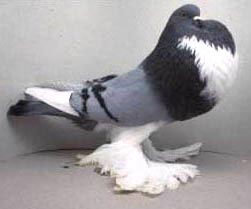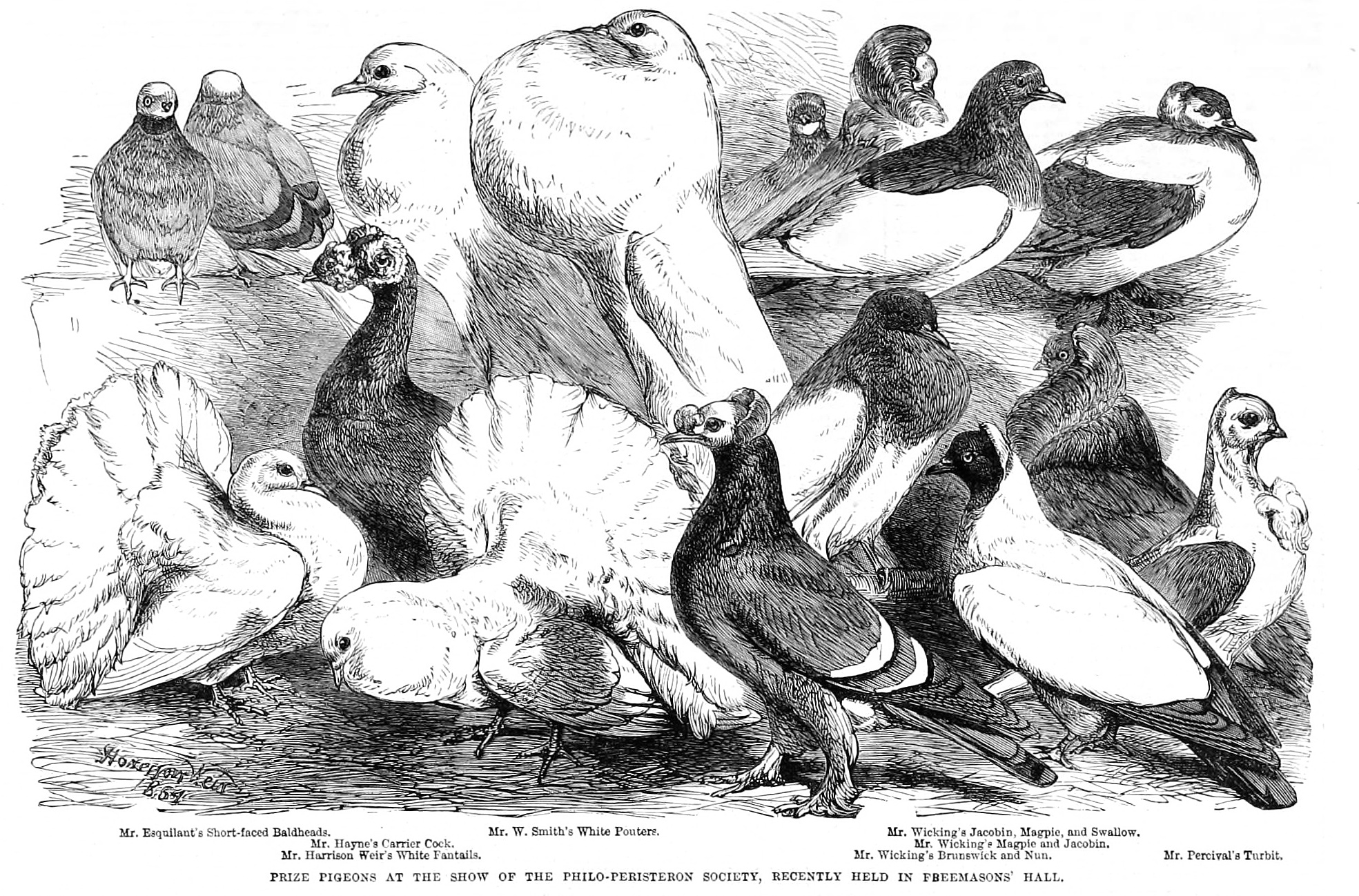|
English Pouter
The English Pouter is a breed of fancy pigeon developed over many years of selective breeding. English Pouters, along with other varieties of domesticated pigeons, are all descendants from the rock pigeon. A breed with an enlarged crop, their distinctiveness was described by Charles Darwin in ''The Variation of Animals and Plants Under Domestication'' (1868). History William Bernhardt Tegetmeier proposed that the English Pouter originated from cross breeding the old pigeon breeds the Dutch Cropper, Uploper and the Parisian Pouter. Each of these breeds is described in works dating from the 17th century. However, in an earlier account, John Moore suggested that the breed was the result of cross breeding between a type of cropper and horseman (both 18th century pigeon types). Historically, the English Pouter was also called the Pouting Horseman, due to the links with the Horseman breed. The modern breeds of croppers, such as the Norwich Cropper, originate from the English ... [...More Info...] [...Related Items...] OR: [Wikipedia] [Google] [Baidu] |
Breed
A breed is a specific group of breedable domestic animals having homogeneous appearance (phenotype), homogeneous behavior, and/or other characteristics that distinguish it from other organisms of the same species. In literature, there exist several slightly deviating definitions. Breeds are formed through genetic isolation and either natural adaptation to the environment or selective breeding, or a combination of the two. Despite the centrality of the idea of "breeds" to animal husbandry and agriculture, no single, scientifically accepted definition of the term exists. A breed is therefore not an objective or biologically verifiable classification but is instead a term of art amongst groups of breeders who share a consensus around what qualities make some members of a given species members of a nameable subset. Another point of view is that a breed is consistent enough in type to be logically grouped together and when mated within the group produce the same type. When bred togeth ... [...More Info...] [...Related Items...] OR: [Wikipedia] [Google] [Baidu] |
William Bernhardt Tegetmeier
William Bernhardt Tegetmeier FZS (4 November 1816 – 19 November 1912) was an English naturalist, a founding member of the Savage Club, a popular writer and journalist of domestic science. A correspondent and friend of Charles Darwin, Tegetmeier studied pigeon breeds and the optimality of hexagonal honeycomb cells constructed by honeybees. He wrote a number of books dealing with home economics, poultry farming, pigeon breeds, bee-keeping and on the maintenance of livestock. Early life Born in Colnbrook, Buckinghamshire, the oldest of three sons, of Sarah Luer and Godfrey Conrad Tegetmeier. His father was a Hanover surgeon who had worked on board the H.M.S. Niobe during the war in America and briefly on a Russian man-of-war. He received his early education at home and when he was twelve, the family moved to London and he worked as an apprentice to his father for five years before studying at the University College London and training at the hospital where he was a clinical ... [...More Info...] [...Related Items...] OR: [Wikipedia] [Google] [Baidu] |
Pigeon Keeping
Pigeon keeping or pigeon fancying is the art and Animal husbandry, science of breeding domestic pigeons. People have practiced pigeon keeping for at least 5,000 years and in almost every part of the world. In that time, humans have substantially altered the Morphology (biology), morphology and the behaviour of the domestication, domesticated descendants of the rock dove to suit their needs for food, aesthetics, aesthetic satisfaction and entertainment. People who breeder, breed pigeons are commonly referred to as pigeon Animal fancy, fanciers.Wendell (1977) 1 The hobby is gaining in popularity in the United States, after having waned within the last 50 years. Both the hobby and commercial aspects of keeping pigeons are thriving in other parts of the world. Types of pigeons kept The rock dove, the wild ancestor of domestic pigeons, was domesticated at least five thousand years ago, when it is first mentioned in historical records from Mesopotamia. There are hundreds of breeds of d ... [...More Info...] [...Related Items...] OR: [Wikipedia] [Google] [Baidu] |
Norwich Cropper
The Norwich Cropper is a breed of fancy pigeon developed over many years of selective breeding. The Norwich Cropper along with other varieties of domesticated pigeons are all descendants from the rock pigeon (''Columba livia''). The Norwich Cropper is thought to have been developed from a breed called the Oploper and is of Dutch origin. See also *List of pigeon breeds This is an alphabetical list of pigeon breeds; these are exclusively breeds of the domestic pigeon (''Columba livia domestica''). Other Columbidae species (e.g., the Barbary dove, ''Streptopelia risoria'') have been domesticated and developed in ... References External links * {{Domesticated-pigeon-breed-stub ... [...More Info...] [...Related Items...] OR: [Wikipedia] [Google] [Baidu] |
Parisian Pouter
Parisian may refer to: * a native or inhabitant of Paris * Standard French, based on the dialect of Paris * Parisian (department store chain), a department store chain bought by Belk, based in Birmingham, Alabama * The Parisian Macao, a casino resort on the Cotai Strip, Macau * Parisian stitch, an embroidery stitch * Josh Parisian (born 1989), American mixed martial artist * Pontiac Parisienne, a full-size rear-wheel drive vehicle * a font designed by Morris Fuller Benton in 1928 * SS ''Parisian'', a steamship in the Allan Line Royal Mail Steamers See also *Parsian (other) Parsian may refer to: * Parsian Bank, a bank in Iran * Parsian, Iran, a city in Iran * Parsian County, an administrative subdivision of Iran * Parsian, Bandar Abbas, a village in Iran See also * Parisian (other) * Persian (disambiguat ... * Paris (other) {{disambig Language and nationality disambiguation pages ... [...More Info...] [...Related Items...] OR: [Wikipedia] [Google] [Baidu] |
Dutch Cropper
The Dutch Cropper is the oldest and largest National fancy pigeon breed in the Netherlands. History As C.A.M. Spruijt points out in his 1929 book ''De Kropperrassen'', the origin of the Dutch Cropper is not very clear. He refers to Ulysses Aldrovandi (1522–1605), who wrote in 1600 about “the great Croppers with muffs at the Batavians” (Holland and Belgium). In English literature the English Pouters came from Holland and Germany. Neumeister describes the Croppers in his first book of 1837. This book was republished in 1876, adapted by Prütz and features colour illustrations including a number of well-known German muffed Cropper breeds, which he called ‘Hollandische Kropf Tauben’. The relationships among the various larger Cropper breeds (Dutch Cropper, Ghent Cropper, Pomeranian Pouter, English Pouter, French Pouter and Saxon Pouter) show a strong resemblance in main breed characteristics. The ancestors of all present Cropper/ Pouter breeds; date to at least 400 y ... [...More Info...] [...Related Items...] OR: [Wikipedia] [Google] [Baidu] |
The Variation Of Animals And Plants Under Domestication
''The Variation of Animals and Plants Under Domestication'' is a book by Charles Darwin that was first published in January 1868. A large proportion of the book contains detailed information on the domestication of animals and plants but it also contains in Chapter XXVII a description of Darwin's theory of heredity which he called pangenesis. Background Darwin had been working for two years writing his "big book", provisionally titled ''Natural Selection (manuscript), Natural Selection'', when on 18 June 1858 he received a parcel from Alfred Wallace, who was then living in Borneo. It enclosed a twenty pages manuscript describing an evolutionary mechanism that was similar to Darwin's own theory. Under pressure to publish his ideas, Darwin started work on an "Abstract (summary), abstract" summary, which was published in November 1859 as ''On the Origin of Species''. In the introduction he announced that in a future publication he hoped to give "in detail all the facts, with ref ... [...More Info...] [...Related Items...] OR: [Wikipedia] [Google] [Baidu] |
Fancy Pigeon
Fancy pigeon refers to any breed of domestic pigeon, which is a domesticated form of the wild rock dove (''Columba livia''). They are bred by pigeon fanciers for various traits relating to size, shape, color, and behavior, and often exhibited at pigeon shows, fairs and other livestock exhibits. There are about 800 pigeon breeds; considering all regional varieties all over the world there may be 1100 breeds. The European list of fancy pigeons alone names about 500 breeds. No other domestic animal has branched out into such a variety of forms and colours. Charles Darwin is known to have crossbred fancy pigeons, particularly the ice pigeon, to study variation within species, this work coming three years before his groundbreaking publication, ''On the Origin of Species''. Pigeon showing Pigeon fanciers from many countries exhibit their birds at local, inter-state or national shows and compete against one another for prizes. One typical country show in Australia in 2008 had hundreds o ... [...More Info...] [...Related Items...] OR: [Wikipedia] [Google] [Baidu] |
Charles Darwin
Charles Robert Darwin ( ; 12 February 1809 – 19 April 1882) was an English Natural history#Before 1900, naturalist, geologist, and biologist, widely known for his contributions to evolutionary biology. His proposition that all species of life have descended from a Common descent, common ancestor is now generally accepted and considered a fundamental scientific concept. In a joint presentation with Alfred Russel Wallace, he introduced his scientific theory that this Phylogenetics, branching pattern of evolution resulted from a process he called natural selection, in which the struggle for existence has a similar effect to the artificial selection involved in selective breeding.. Darwin has been described as one of the most influential figures in human history and was honoured by Burials and memorials in Westminster Abbey, burial in Westminster Abbey. Darwin's early interest in nature led him to neglect his medical education at the University of Edinburgh Medical Schoo ... [...More Info...] [...Related Items...] OR: [Wikipedia] [Google] [Baidu] |
Crop (anatomy)
The crop (also the croup, the craw, the ingluvies, and the sublingual pouch) is a thin-walled, expanded portion of the alimentary tract, which is used for the storage of food before digestion. The crop is an anatomical structure in vertebrate animals, such as birds, and invertebrate animals, such as gastropods (snails and slugs), earthworms, leeches, and insects. Insects Cropping is used by bees to temporarily store nectar of flowers. When bees "suck" nectar, it is stored in their crops. Other Hymenoptera also use crops to store liquid food. The crop in eusocial insects, such as ants, has specialized to be distensible, and this specialization enables important communication between colonial insects through trophallaxis. The crop can be found in the foregut of insects. Birds In a bird's digestive system, the crop is an expanded, muscular pouch near the gullet or throat. It is a part of the digestive tract, essentially an enlarged part of the esophagus. As with most oth ... [...More Info...] [...Related Items...] OR: [Wikipedia] [Google] [Baidu] |






